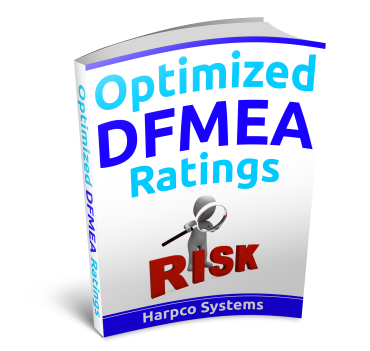Note: This article originally appeared in Quality Magazine under the title “Quality 101: Demystifying Design FMEAs”
Optimized Method For Establishing Design FMEA Ratings Part I
by Richard Harpster, President of Harpco Systems
The purpose of the paper is to provide the reader with an efficient methodology for establishing Design FMEA ratings to ensure that issues in the Design FMEA representing the greatest financial risk to the company are identified so proper actions can be taken to resolve them. If you have ever spent hours debating how to properly arrive at the ratings for your Design FMEAs or completed the ratings only to find out that the calculated Risk Priority Numbers (RPN) are telling you to work on issues that you know are not the ones you should be working on, the following methodology will help you.
The rating tables used in the methodology are based on tables found in the Potential Failure Mode and Effects Analysis (FMEA) Reference Manual, Third Edition, July 2001. Some modifications are made to these tables to increase their effectiveness. For individuals reading this paper who may be concerned that they may not be compliant with QS9000 or TS16949 guidelines if they follow the methodology because of the changes to the tables, the Potential Failure Mode and Effects Analysis (FMEA) Reference Manual gives permission for the changes introduced in the paper. Prior to the presentation of each table, the manual states: “Suggested Evaluation Criteria: The team should agree on an evaluation criteria and ranking system that is consistent, even if modified for individual product analysis.” No company who has ever used the methodology enclosed in this paper has ever failed an ISO9000, QS9000 or TS16949 audit because of its use.
Design FMEA Purpose Review
Before we discuss how to arrive at the proper ratings for your Design FMEAs lets review the purpose of the Design FMEA. The Design FMEA is a point in time audit of the adequacy of the Design Specifications in defining a product capable of meeting the product design requirements. Using ISO terminology, you are trying to assess how well the design outputs meet the design input requirements.
| Function | Failure Mode | Effects of Failure | S e v |
C l a s s |
Failure Cause | O c c u r |
Prevention Controls | Detection Controls | D e t e c t |
R P N |
| Resistant to road impact forces for 10 years/ 100K miles | Component structural failure | Noise, Loss of HVAC auto-climate control function | 8 | Component material thickness is specified too thin | 1 | Road durability testing | 6 | 48 | ||
| Component material type is incorrectly specified | 4 | Road durability testing | 7 | 224 |
In the example provided, the Design FMEA is used to assess how well the design meets the design requirement that it must survive road impact forces for the products intended life. Based on the example’s content, we know that due to exposure to road impact forces there is a concern that a component could experience structural failure either because the material thickness of the component is specified to thin or the wrong material has been chosen for the component. We also know that if the structural failure occurs, noise and/or the loss of the HVAC auto-climate control function will follow. Road durability testing has been done to assess whether the product has been properly designed to prevent the component structural failure due to the road impact forces.
Establishing the Design FMEA Severity Rating
The first rating that must be determined is the severity rating. The first step in assigning a severity rating is to identify the worst effect documented in the effects column. In the case provided, the worst effect is the loss of the non-safety related function. Once the worst effect has been identified, a ranking is assigned based on a severity rating table. A typical severity rating table used to rate a Design FMEA is as follows:
| Rating | Criteria: Severity of Effect |
| 10 | Safety issue and/or non-compliance with government regulation without warning. |
| 9 | Safety issue and/or non-compliance with government regulation with warning. |
| 8 | Loss of primary function. |
| 7 | Reduction of primary function. |
| 6 | Loss of comfort/convenience function. |
| 5 | Reduction of comfort/convenience function. |
| 4 | Returnable appearance and/or noise issue noticed by most customers. |
| 3 | Non-returnable appearance and/or noise issue noticed by customers. |
| 2 | Non-returnable appearance and/or noise issue rarely noticed by customers. |
| 1 | No discernable effect. |
A close look at the table reveals that the rankings can be grouped in three zones of financial risk. These zones are called the Safety/Legal Zone, Return/No Buy Zone and Conditioned Response Zone. Although the rankings are different within each zone, each ranking represents the same financial risk to the company.
The Safety/Legal Zone is comprised of rankings 9 and 10. When someone gets injured or a government regulation is violated, the company is exposed to the greatest level of financial risk. Although warnings can help in limiting the financial damages that the company will incur when an injury occurs, their effect is often negligible.
The Return/No Buy Zone is comprised of rankings 5-8 if the product would never be returned for an appearance/noise issue and 4-8 if the product could be returned for an appearance/noise issue. In the Design FMEA presented in the example, there might be considerable argument on whether the function lost is a primary function or a comfort/convenience function. As an example, if the automatic climate control feature of the HVAC system is lost but the heating and air conditioning can be manually adjusted to achieve the desired comfort, is the loss of the automatic climate control a loss of a primary function, reduction of a primary function, loss of a comfort/convenience function or reduction of a comfort/convenience function? FMEA groups often debate for long periods of time over this type of issue.
The answer to the question is that it does not matter how you label the effect. The typical customer expects a product to work and does not divide its functions into primary and comfort/convenience. If the smallest function of a product is not provided, the customer’s expectation is that it will be fixed. In many cases the cost of repair of a “comfort/convenience” issue is the same as if the main function of the product were lost.
The final zone is the Conditioned Response Zone and is comprised of rankings 1-3. Effects that are given these rankings represent no current financial risks to the company. When a customer accepts an objectionable noise or appearance issue and does not demands its repair, it means that they have been conditioned to accept the defect as normal. Companies ship Conditioned Response Zone defects every day. The danger of this zone is that items that are Conditioned Response Zone issues today can be Return/No Buy Zone issues tomorrow. One only has to think about the changes that have occurred for the noise and appearance requirements of automobiles for the past 10 years if they want an example of this happening.
Using the above zone definitions, it is possible to construct an efficient method for establishing severity rankings. The method is as follows:
- Define the Safety/Legal Zone, Return/No Buy Zone and Conditioned Response Zone zones before you begin to assign any ratings.
- Decide what you are going to do if the group all agrees on the zone that the effect belongs to, but disagrees on the rating to be applied to it. You have two choices.
- Average all the ratings and round up or select the highest rating. Averaging should be used when possible to reduce the influence of a single highly negative individual.
- Rate the effects. Ask each member what zone they believe the worst effect falls into. If they agree on the same zone, ask them for their rating and apply the rule you selected in item 2.
- If they disagree on the zone, allow the representatives from each zone one minute to state why they believe the way they do. Have everyone re-rate the effect. If they still disagree on zone, select the worst case zone and apply to rule developed in item 2 to any ratings that fall within the zone. If they now agree on zone, apply rule 2.
Never forget that the assignment of the severity ratings is a subjective process. If the method provided is followed, you should never spend more than 3 minutes on any rating and in most instances the rating should be established in a matter of seconds.
Some readers may now be asking themselves about the impact of the above severity rating setting methodology on Risk Priority Number (RPN) ratings. If you are concerned, don’t worry. Although RPN is identified by most FMEA manuals as the method to be used to determine the issues you should be working on, if you use RPN as your main tool for prioritization, you risk being wrong as often as 50% of the time. A better way for prioritizing issues to be worked on in the Design FMEA will be provided at the end of this paper.
Want to save this whole article in your files?
Click the book and we’ll send it to your email:
Note:
In Part II of this paper DFMEA Occurrence Ratings are explained:
Establishing Design FMEA Ratings Part II
In Part III, the limitations of RPN and SxO ratings are discussed:
Establishing Design FMEA Ratings Part III
“Harpco breaks down the barriers and corrects the pitfalls so companies can reap the full benefits of FMEA. Classroom training not only properly teaches FMEA, but participants actually build their business’s FMEA as they go and are often blown away by how much work got accomplished. Harpco Systems has become known as the Modern FMEA for a reason. Its structured, simplified and sustainable.”
“We used QPlus to achieve Q1 and ISO 16949 successfully at the Ford Motor Co. Monroe BAO Plant. The software promoted linked documentation that prevented issues at internal and external audits. Assured the quality documents at the operations production level had all relevant and concurrent information that was reviewed in the program files. QPlus allowed the program members to create a baseline “Hot End Exhaust” database that produced linked documentation from the DFMEA to the production visual aids the operators used to perform correctly.”
“Harpco’s training is first rate and helps develop new ways of thinking about the importance of creating proper specifications early. Separately, I’ve seen firsthand the effectiveness of using their approach in problem solving, helping to advance problems that had reached a stall using traditional methods.”
“We were very fortunate to work with Rich Harpster and his team as we improved our DFMEA process at Calsonic. There is no better teacher, coach, implementer than Rich when it comes to creating a knowledge base for engineers to use in creating part specs to assure that products meet the customer’s requirements. Rich teaches the basics, then he accelerates the FMEA process so that requirements and specs are related in a database that can be continually updated.”
“I would like to thank Harpco Systems for the help, advice and frankly the education in how to design, develop, source and manufacture new to world products.”







